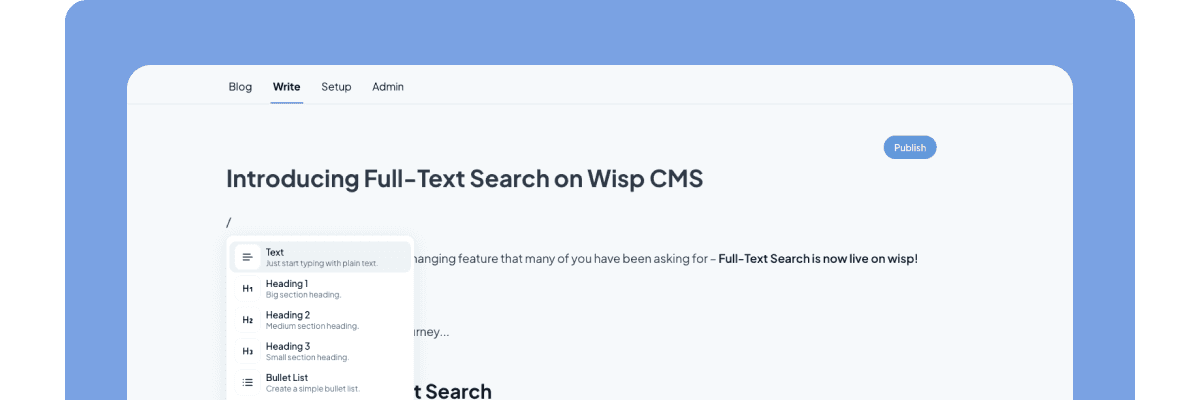
Introduction
Selecting the right Content Management System (CMS) is critical for startups. A Headless CMS, which decouples the backend management from frontend presentation, offers flexibility, scalability, and enhanced performance. For startups, choosing the right CMS is crucial to support growth, ease content management for non-technical users, and scale with expanding needs.
Understanding Headless CMS
What is a Headless CMS?
A Headless CMS is a backend-only content management system that manages content and makes it accessible via an API. Unlike traditional monolithic CMS platforms that couple content management and presentation tightly, a Headless CMS separates these concerns. This decoupling allows content to be displayed on any frontend, providing significant flexibility.
Benefits of a Headless CMS
Flexibility: The decoupled architecture enables using the CMS across various channels and devices, making it highly adaptable.
Scalability: It efficiently handles increased traffic and content volume, ensuring smooth performance as the startup grows.
Ease of Integration: APIs allow seamless integration with other tools and platforms, ensuring a cohesive tech stack.
Enhanced Security: By separating content management from the frontend, the attack surface is reduced, enhancing security.
Better Performance: Headless CMS platforms support faster content delivery through Content Delivery Networks (CDNs) and static site generators.
Key Considerations for Startups
Ease of Use for Non-Technical Users
Importance: For startups, making the content creation and management process seamless for non-technical users is vital. A user-friendly interface ensures that content tasks do not always require developer intervention.
Examples: Platforms like Wisp CMS excel in offering intuitive interfaces tailored for non-technical users, making it easier to manage content without technical expertise.
Scalability
Why Important: As startups grow, their website traffic and content volume will increase. A scalable CMS ensures that the platform can handle this growth without compromising performance.
Features: Look for efficient data management, CDN support, and robust APIs.
Examples: Wisp, Contentful, Sanity, and Strapi are known for their scalability.
Developer Experience
Importance: A CMS that is developer-friendly streamlines the development process and enhances productivity.
Features: Support for multiple frameworks, comprehensive documentation, and SDKs (Software Development Kits).
Examples: Wisp, Strapi, Contentful, and Sanity provide excellent developer tools.
Content Management and Workflow
Importance: Streamlined content workflows improve team efficiency and collaboration.
Features: Version control, collaborative tools, and intuitive content editors are essential.
Wisp CMS: Offers features like automatic image optimization, drag-and-drop capabilities, and powerful slash commands, enhancing content management for teams.
Performance and Speed
Importance: High performance and speed are crucial for user experience and Search Engine Optimization (SEO).
Tools: CDNs, static site generators, and an API-first architecture boost performance.
Platforms: Wisp, Contentful, Prismic, and ButterCMS are known for their high performance.
Security
Importance: Protecting against data breaches and attacks is paramount for any startup.
Features: Modern authentication methods like OAuth, JSON Web Tokens (JWT), and role-based access controls are essential.
Platforms: Contentful and Sanity are known for their robust security features.
Budget and Cost Management
Importance: Startups need to balance cost with functionality and scalability.
Wisp CMS: Provides a cost-effective solution with essential features, making it ideal for startups.
Top Headless CMS Options to Consider
Wisp CMS

Overview & Key Features: Wisp CMS is designed to simplify adding stories to websites. It offers a seamless setup, a powerful API, and a clean writing environment. It is optimized for SEO and provides a delightful experience for writers and developers alike.
Pros: Strong focus on editorial experience and ease of integration for developers. Built in AI-suggested related articles and full-text search feature without any additional configurations.
Cons: Since it was built specifically for the best blog experience, it's not suitable for editing other pages on the website.
Contentful
Overview & Key Features: Contentful is an API-first CMS with a flexible content modeling system. It supports extensive third-party integrations and is popular among developers for its robust content management tools.
Pros: Developer-friendly, rich features, and extensive integration options.
Cons: High pricing and can be complex for beginners.
Strapi
Overview & Key Features: Strapi is an open-source CMS that allows customizing content structures and supports both RESTful and GraphQL APIs. It is highly customizable and developer-oriented.
Pros: Flexibility, customization, and extensive developer tools.
Cons: Steep learning curve and requires technical expertise.
Prismic
Overview & Key Features: Prismic offers custom types and fields, a rich text editor, and versioning support. It is API-first and supports both RESTful and GraphQL APIs.
Pros: Flexible content modeling, user-friendly, and robust features.
Cons: Higher pricing and smaller community support.
Sanity
Overview & Key Features: Sanity enables real-time collaboration and offers a customizable editor interface. It supports RESTful and GraphQL APIs and is known for its flexibility and real-time updates.
Pros: Real-time collaboration, flexible content management, and extensive developer tools.
Cons: Requires technical expertise and has a smaller community.
ButterCMS
Overview & Key Features: ButterCMS provides customizable content types, user-friendly editors, and extensive integrations. It is developer-friendly and offers a flexible framework for managing content.
Pros: Flexibility, ease of integration, and developer-friendly.
Cons: Lacks built-in analytics and requires technical setup.
Conclusion
Choosing the right Headless CMS is crucial for startups to support growth, ease content management for non-technical users, ensure scalability, and provide robust security.
Wisp CMS, with its simplicity, scalability, and user-friendly features, is highly recommended for startups looking to thrive in the digital space.
Try out their editor today to experience distraction free editing. Alternatively, fork one of their NextJS Blog Starter Kit to get a blog up and running in 15 mins or less.



